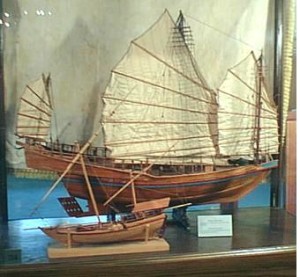The Ship
The model on display portrays a modern junk typical of Canton or Hong Kong in southeast China, where 17th Century Dutch influence resulted in pointed, rather than the blunt bows of classic Chinese construction.
Twentieth Century scholarship points to an evolutionary process that evolved from the timber bamboo rafts (still in use in Taiwan in the early 20th Century) to the unique Chinese hull, around 400 AD.
The classic junk first reported by Marco Polo, in the late 13th Century, is a relatively flat-bottomed hull, rockered fore and aft and devoid of a European keel, or stem and stern posts. Their weather decks frequently overhang the hull, particularly at the bow and stern. Chinese masts are heavier than those of Europe and require practically no standing rigging. Their balanced axial rudders predated occidental rudders by about four centuries. Chinese lug sail rigs can be traced back to the days of bamboo rafts.
Chinese junks of the 15th Century attained a size that would have allowed them to deck load one of Vasco de Gama’s 15th Century ships of exploration.
The Model
Scale: ¼” Case H 58 ½” L 49 ¾” W 23 ½”
Solid hull. Built by the Murray family
